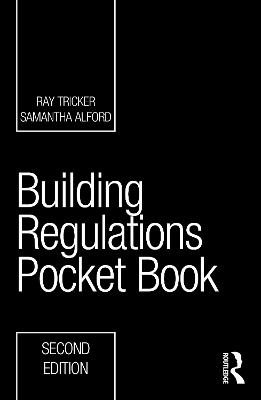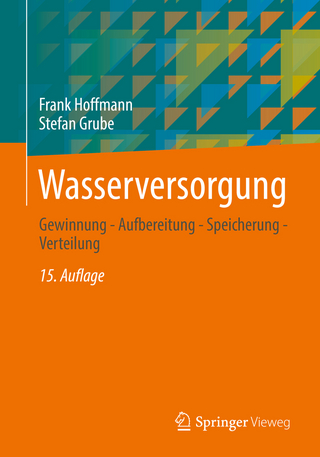
Building Regulations Pocket Book
Routledge (Verlag)
978-0-367-77417-2 (ISBN)
The new edition of the Building Regulations Pocket Book has been fully updated with recent changes to the UK Building Regulations and Planning Law. This handy guide provides you with all the information you need to comply with the UK Building Regulations and Approved Documents. On site, in the van, in the office – wherever you are – this is the book you’ll refer to time and time again to check the regulations on your current job.
Part 1 provides an overview of the Building Act.
Part 2 offers a handy guide to the dos and don’ts of gaining the Local Council’s approval for Planning Permission and Building Regulations Approval.
Part 3 presents an overview of the requirements of the Approved Documents associated with the Building Regulations.
Part 4 is an easy-to-read explanation of the essential requirements of the Building Regulations that any architect, builder or DIYer needs to know to keep their work safe and compliant on both domestic and non-domestic jobs.
Key new updates to this second edition include, but are not limited to: changes to the fire regulations as a result of the Hackitt Review, updates to Approved Document F and L, new Approved Documents covering Overheating (AD-O) and Infrastructure for the charging of electric vehicles (AD-S), amendments to and the reinstatement of the Manual to the Building Regulations. This book is essential reading for all building contractors and sub-contractors, site engineers, building engineers, building control officers, building surveyors, architects, construction site managers as well as DIYers and those who are supervising work in their own home.
Ray Tricker is a Senior Consultant with over 50 years continuous service in Quality, Safety and Environmental Management, Project Management, Communication Electronics, Railway Command, Control and Signalling Systems, Information Technology and the development of Molecular Nanotechnology. He served with the Royal Corps of Signals (for a total of 37 years) during which time he held various managerial posts culminating in being appointed as the Chief Engineer of NATO’s Communication Security Agency (ACE COMSEC). Most of Ray's work since leaving the Services has centred on the European Railways. Samantha Alford (MSc, MCIPS) is an established compliance and business management consultant and technical author. She served in the Royal Air Force for 18 years and has over 35 years of experience in a range of fields including Governance, Oversight and Strategic Planning, and Compliance. Sam has worked in the public, private, charity and voluntary sectors and is currently Director of a consultancy providing data protection guidance to small businesses and technical authorship.
PART 1: Background information 1.1 What is the Building Act 1984? 1.2 What does the Building Act 1984 contain? 1.3 What are the Supplementary Regulations? 1.4 What are ‘Approved Documents’? 1.5 How are buildings classified? 1.6 Who polices the Building Act? 1.7 What to comply with the Building Regulations 1.8 What are the duties of the Local Authority? 1.9 What are the powers of the Local Authority 1.10 What is the ‘Building Regulations Advisory Committee’? 1.11 Who are Approved Inspectors? 1.12 Does the Fire Authority have any say in Building Regulations? 1.13 What Notices and Certificates are required? 1.14 Are there any exemptions to the Building Regulations? 1.15 Can appeals be made against a Local Authority’s ruling? 1.16 What about dangerous buildings? 1.17 What about defective buildings? 1.18 What are the rights of the owner or occupier of the premises? PART 2: Requirements for Planning Permission and Building Regulations approval 2.1 Introduction 2.2 Additional storeys/extending upwards 2.3 Advertising and signs 2.4 Aerials, satellite dishes and flagpoles 2.5 Basements 2.6 Biomass-fuelled Appliances 2.7 Ceilings and floors 2.8 Central heating and boilers 2.9 Change of use 2.10 Conservatories 2.11 Conversions 2.12 Decoration and repairs inside and outside a building 2.13 Demolition 2.14 Doors and windows 2.15 Drains and sewers 2.16 Electrical work in the home and garden 2.17 Extensions 2.18 External walls 2.19 Fascias 2.20 Fences, gates and garden walls 2.21 Flats and maisonettes 2.22 Flues, chimneys and soil and vent pipes 2.23 Fuel tanks 2.24 Garages and carports 2.25 Hardstanding for cars, caravans and boats 2.26 Heat pumps 2.27 Hedges 2.28 Home energy generation 2.29 Hydroelectricity 2.30 Insulation 2.31 Internal walls 2.32 Kitchens and bathrooms 2.33 Loft conversions 2.34 Micro combined heat and power Microgeneration Certification Scheme 2.35 New homes and self-build homes 2.36 Outbuildings 2.37 Patios, decking and driveways 2.38 Paving your front garden 2.39 Plumbing 2.40 Porches 2.41 Roofs 2.42 Security lighting 2.43 Shops 2.44 Solar panels 2.45 Structural alterations - inside 2.46 Swimming pools 2.47 Trees 2.48 Underpinning 2.49 Warehouses and industrial buildings 2.50 Wind turbines 2.51 Working from home PART 3: Requirements of the Approved Documents 3.1 Introduction 3.2 A - Structure 3.3 B - Fire safety: Volume 1: Dwellings and Volume 2: Buildings other than dwellings 3.4 C - Site preparation and resistance to contaminants and moisture 3.5 D - Toxic substances 3.6 E - Resistance to the passage of sound 3.7 F - Ventilation 3.8 G - Sanitation, hot water safety and water efficiency 3.9 H - Drainage and waste disposal 3.10 J - Combustion appliances and fuel storage systems 3.11 K - Protection from falling, collision and impact 3.12 L - Conservation of fuel and power: Volume 1: Dwellings and Volume 2: Buildings other than dwellings 3.13 M - Access to and use of buildings: Volume 1: Dwellings and Volume 2: Buildings other than dwellings 3.14 O - Overheating 3.15 P - Electrical safety: Design and installation of electrical installations 3.16 Q - Security in dwellings 3.17 R - High-speed electronic communication networks 3.18 S - Infrastructure for the charging on electric vehicles 3.19 Regulation 7 - Materials and workmanship PART 4: Meeting the requirements of the Building Regulations 4.1 Introduction 4.2 Foundations 4.3 Ventilation 4.4 Drainage 4.5 Cellars and basements 4.6 Floors 4.7 Walls 4.8 Ceilings 4.9 Roofs 4.10 Chimneys and fireplaces 4.11 Stairs 4.12 Windows 4.13 Doors 4.14 Access routes 4.15 Corridors and passageways 4.16 Sanitary accomodation, bathrooms and showers 4.17 Electrical safety 4.18 Combustion appliances 4.19 Hot water storage 4.20 Liquid fuel storage 4.21 Kitchens and utility rooms 4.22 Loft conversions 4.23 Extensions and additions to buildings 4.24 Conservatories
| Erscheinungsdatum | 19.08.2022 |
|---|---|
| Reihe/Serie | Routledge Pocket Books |
| Zusatzinfo | 105 Tables, black and white; 1 Line drawings, black and white; 3 Halftones, black and white; 4 Illustrations, black and white |
| Verlagsort | London |
| Sprache | englisch |
| Maße | 129 x 198 mm |
| Gewicht | 720 g |
| Themenwelt | Naturwissenschaften ► Biologie ► Ökologie / Naturschutz |
| Technik ► Bauwesen | |
| Technik ► Elektrotechnik / Energietechnik | |
| Weitere Fachgebiete ► Handwerk | |
| ISBN-10 | 0-367-77417-8 / 0367774178 |
| ISBN-13 | 978-0-367-77417-2 / 9780367774172 |
| Zustand | Neuware |
| Informationen gemäß Produktsicherheitsverordnung (GPSR) | |
| Haben Sie eine Frage zum Produkt? |
aus dem Bereich


